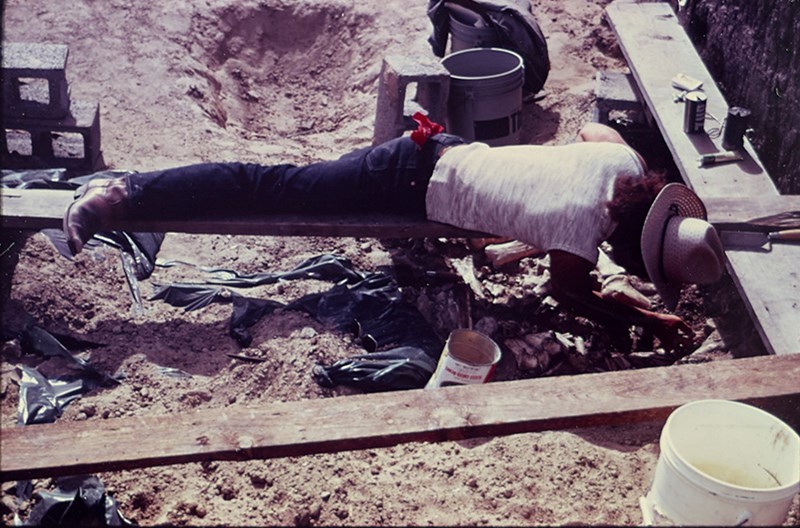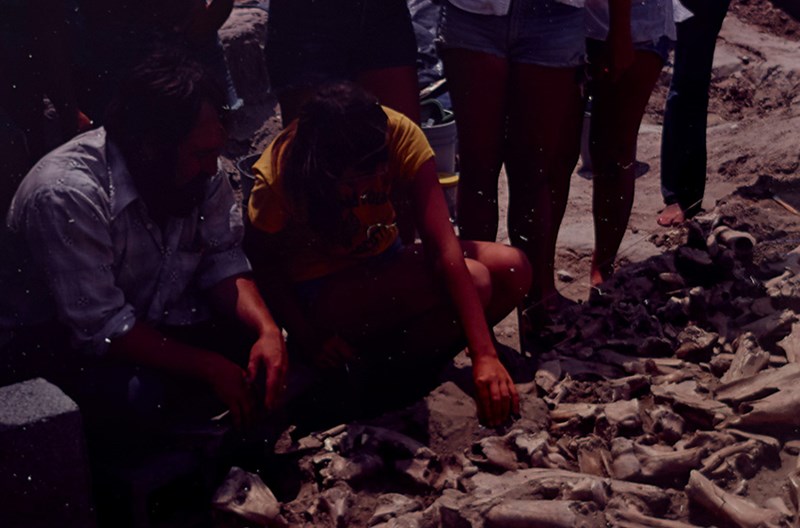
Caring for the Jones-Miller Legacy Collection
Written by: Natalie A. Patton and Amy M. Gillaspie; Produced by: Maurilio Tapia
Spring/Summer Issue
When we moved the collection from the Smithsonian Institute to the Denver Museum of Nature & Science, all the bones were carefully packed in boxes and organized by type of bone, following how they were organized at the Smithsonian. This meant, for example, that all of the ribs were housed together, all of the femurs were housed together and all of the toes were housed together. This method of organizing a faunal collection is useful toanswer some research questions, so we decided to keep it organized in this way while adding an additional step of organizing it based on the location it was excavated from. To organize it this way, we first had to understand how the site was excavated.
At the Jones-Miller excavation, which took place from 1973 to 1975, archaeologists divided the site into 2x2 meter squares, which we call units. They gave each of these units a unique number designation based on a grid they outlined over the site. They labeled the rows “A” through “O” and the columns “100” through “112.” This means that a unit label consists of a letter followed by a number, such as unit “J103” or “M107.”

An archaeologist lays across a wooden plank to access hard to reach places, 1972. (Credit/Denver Museum of Nature & Science)
To rehouse the collection, our first step was then to take all the bones and sort them into the different units from which they were excavated. The bones are typically housed in old plastic bags or were loose in the boxes they were packed in. This old packaging can be problematic because bags wear down or tear over time, so we end up with loose pieces of bone that cannot be reconciled with the bones they broke from. Loose bones can also be a problem for preservation because as the bones move, rub and collide with one another, it causes damage. Rehousing these bones by taking them out of the old bags and placing them in new archival quality bags or custom mounts protects and preserves the bones from additional or future breakage.
After the bones are in new bags, they are given a new catalog number. All relevant information about that bone is written on the archival bag and recorded into our database. This information includes what excavation unit the bone came from, if it was given a unique number in the field when it was excavated or if there are any additional notes that are relevant to how the bone was found in the field. This information is saved in our database and can be referenced by Museum personnel and visiting researchers in the future. We then place the bags into new archive-quality boxes that we custom build in-house. Bones from the same excavation units are then kept together in these boxes using dividers so they will stay organized and easy to separate during future research, if needed. After that, these completed boxes are placed in cabinets in the Avenir Collections Center, making the Jones-Miller site far more available and accessible for research than before.
Join Collection Assistants, Amy Gillaspie and Natalie Patton, as they discuss how they care for 41,000 year old bison bones.
So, what does all this work mean for the future? The Jones-Miller collection has great potential to tell us more about the people of North America, commonly referred to as Paleoindians, who hunted in northeastern Colorado more than 10,000 years ago. As we continue processing this collection, we learn more about what we call “activity areas,” including where the people would sharpen stone tools. We are learning more about how the animal butchering and processing occurred at the site, including areas where fires were used to help extract and process bone marrow.
Throughout 2022, we shared the collection and our processing progress with multiple students, from elementary school-age summer camps to high school-age Teen Science Scholars, to undergraduate and graduate students and their professors. Visiting researchers have traveled to our Museum to study the sources of stone used to make the tools found at the site and to analyze the possible presence of bone tools in the collection. The results of these studies are shedding new light on this collection and Paleoindian archaeology in general.
Additionally, we continue to share these findings and our process with avocational and professional archaeologists. In October 2022, we traveled to Oklahoma City, Oklahoma for the 79th Annual Plains Anthropological Society conference, where we met several people who worked at or visited the Jones-Miller site five decades ago while it was excavated. They shared their excitement regarding the Museum’s work on this important collection. We will continue to present results of this research at two conferences in 2023: the Colorado Council of Professional Archaeologists conference in March and then again at the 2023 Plains Anthropological Society conference this fall. We invite you to stay tuned to Catalyst and our Museum social media platforms for updates

Archaeologist Dennis Stanford and student closely examine the exposed bones from the Jones-Miller Site, 1972. (Credit/Denver Museum of Nature & Science)
